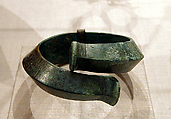Bronze armlet
A massive, solid armlet of a well-known type, with overlapping and slightly tapering ends, carinated and richly decorated on the outside, undecorated, slightly concave and relatively smooth on the inside. The external surface is adorned with engraved linear designs (hatched lozenges and triangles) and punched circular patterns. The flat ends flare out and bear a pattern of dice (five punched spots).
The heavy armlet belongs to the group of the so-called Macedonian bronzes, a wide range of bronze ornaments made in the northwest Aegean and south-central Balkans (late 8th-early 5th c. BCE), mostly found in elite female tombs. Though an autonomous stylistic group, Macedonian bronzes present strong artistic connections with the neighboring Hallstatt culture of central Europe and were influenced by the Greek presence in the south (notably Thessaly and Corinth).
In Tomb 111 of Milci-Gevgelija (southeast of the Republic of North Macedonia), a woman’s skeleton was still wearing a pair of similar armlets (of the Janjevo Type) above each elbow. The type was also widely distributed from the Northern Balkans to the Illyrian coast, and in Greek sanctuaries, such as Olympia, Sparta, Dodona, and Delphi.
Due to rights restrictions, this image cannot be enlarged, viewed at full screen, or downloaded.

